MOD003379 - Actual vs. Apparent Authority in Agency Law Context
VerifiedAdded on 2023/06/04
|13
|3214
|321
Essay
AI Summary
This essay provides a comprehensive analysis of agency law, focusing on the critical distinction between actual and apparent authority. It begins by defining agency and its relevance in modern business, highlighting the fiduciary relationship between principal and agent. The essay then delves into the different types of authority, including actual express, actual implied, and apparent (ostensible) authority, supported by case laws and examples. It further discusses the three requirements needed to bind a principal to an agent's authority under apparent authority: representation by the agent, representation by the principal, and reliance by the third party. The essay concludes by comparing actual and apparent authority, offering a personal opinion on the clarity of their differences and suggesting potential reforms, all while providing references to relevant journals and magazines. The complete essay is available on Desklib, where students can find a wealth of study resources, including past papers and solved assignments.
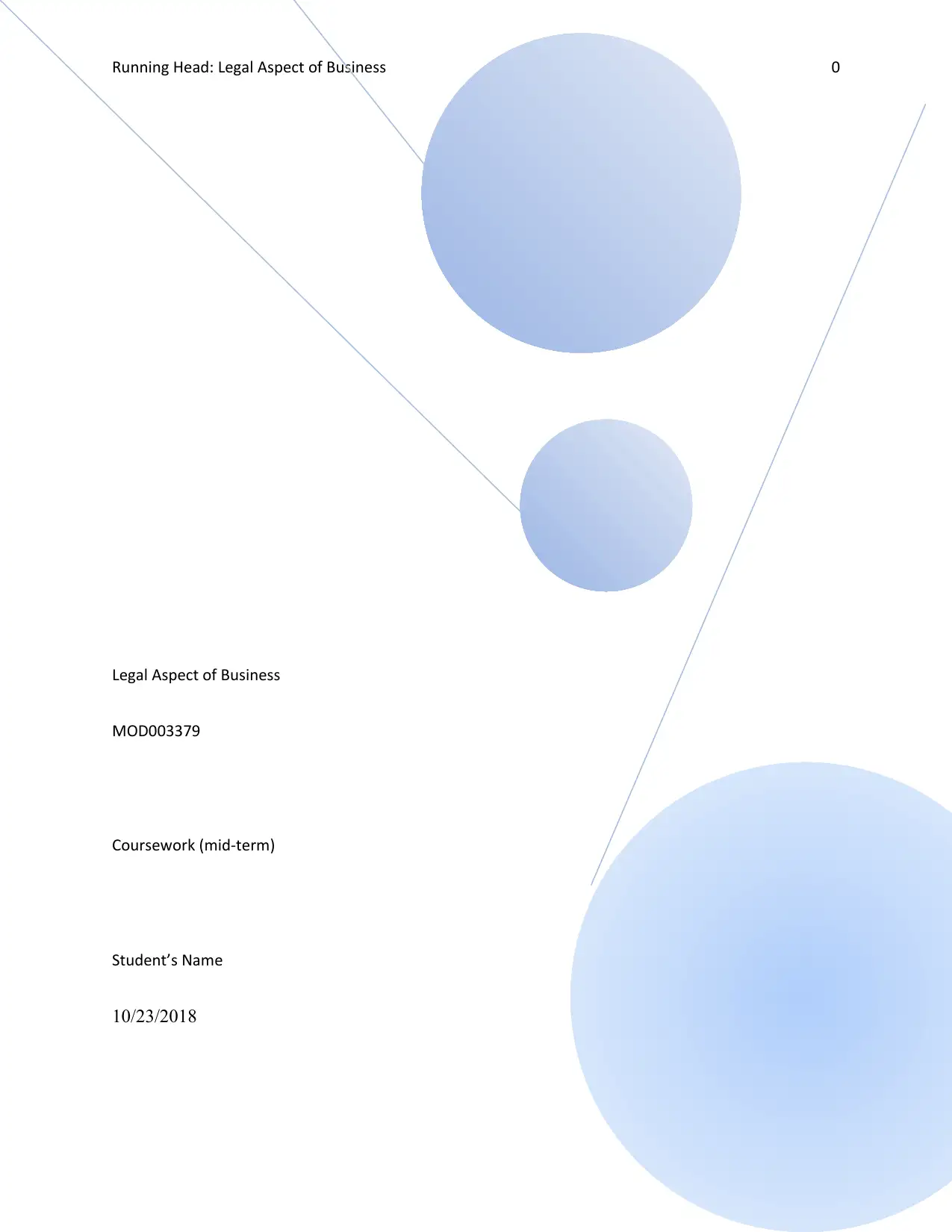
Running Head: Legal Aspect of Business 0
Legal Aspect of Business
MOD003379
Coursework (mid-term)
Student’s Name
10/23/2018
Legal Aspect of Business
MOD003379
Coursework (mid-term)
Student’s Name
10/23/2018
Paraphrase This Document
Need a fresh take? Get an instant paraphrase of this document with our AI Paraphraser
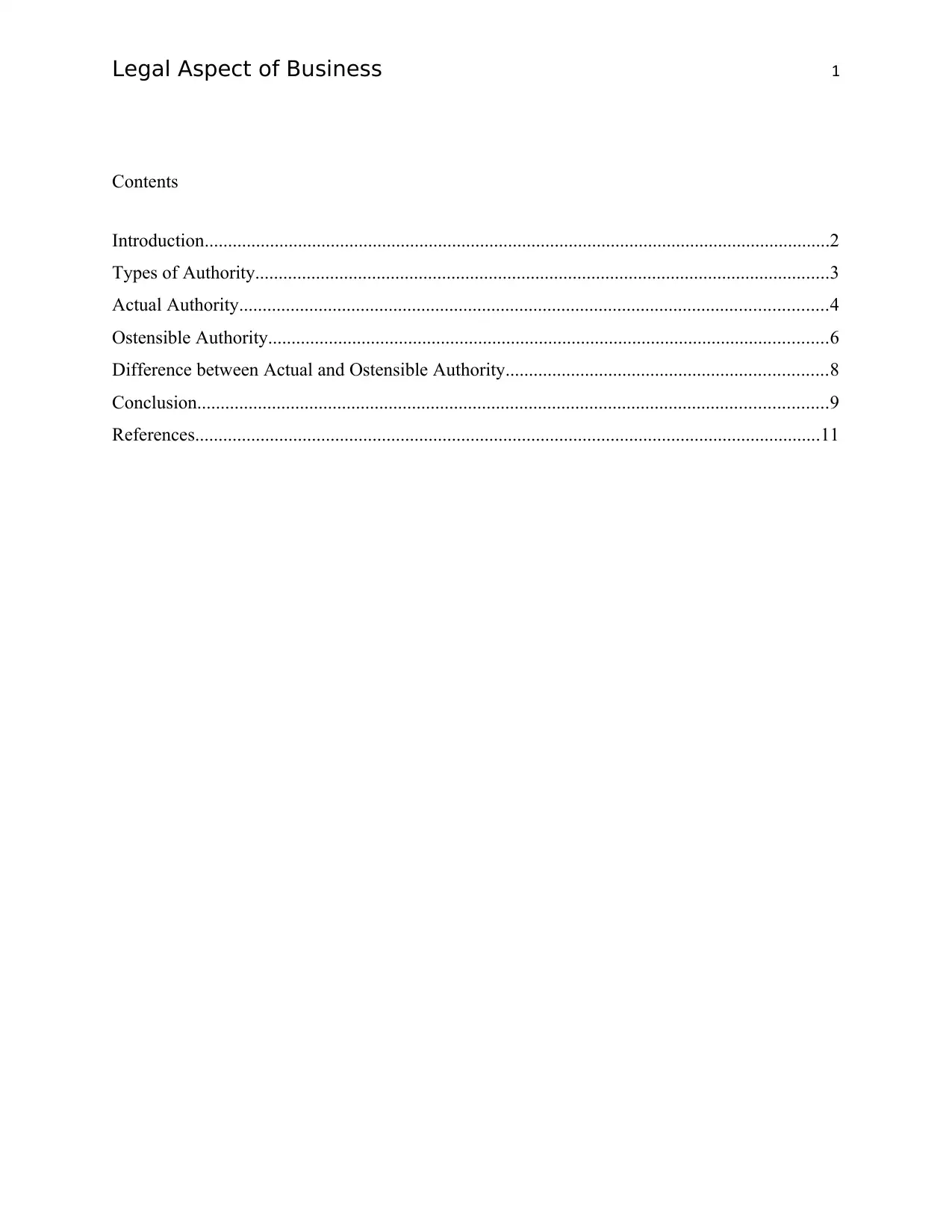
Legal Aspect of Business 1
Contents
Introduction......................................................................................................................................2
Types of Authority...........................................................................................................................3
Actual Authority..............................................................................................................................4
Ostensible Authority........................................................................................................................6
Difference between Actual and Ostensible Authority.....................................................................8
Conclusion.......................................................................................................................................9
References......................................................................................................................................11
Contents
Introduction......................................................................................................................................2
Types of Authority...........................................................................................................................3
Actual Authority..............................................................................................................................4
Ostensible Authority........................................................................................................................6
Difference between Actual and Ostensible Authority.....................................................................8
Conclusion.......................................................................................................................................9
References......................................................................................................................................11
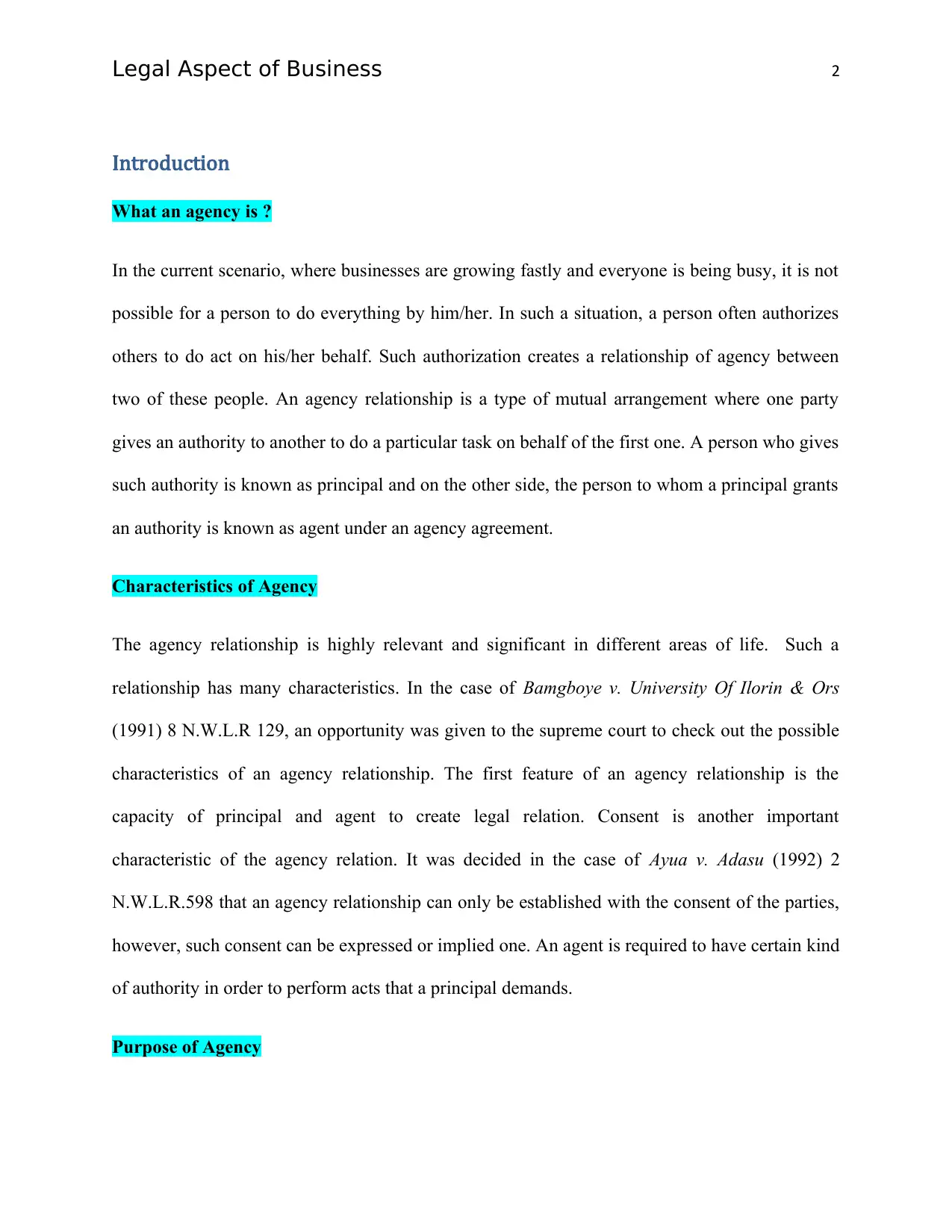
Legal Aspect of Business 2
Introduction
What an agency is ?
In the current scenario, where businesses are growing fastly and everyone is being busy, it is not
possible for a person to do everything by him/her. In such a situation, a person often authorizes
others to do act on his/her behalf. Such authorization creates a relationship of agency between
two of these people. An agency relationship is a type of mutual arrangement where one party
gives an authority to another to do a particular task on behalf of the first one. A person who gives
such authority is known as principal and on the other side, the person to whom a principal grants
an authority is known as agent under an agency agreement.
Characteristics of Agency
The agency relationship is highly relevant and significant in different areas of life. Such a
relationship has many characteristics. In the case of Bamgboye v. University Of Ilorin & Ors
(1991) 8 N.W.L.R 129, an opportunity was given to the supreme court to check out the possible
characteristics of an agency relationship. The first feature of an agency relationship is the
capacity of principal and agent to create legal relation. Consent is another important
characteristic of the agency relation. It was decided in the case of Ayua v. Adasu (1992) 2
N.W.L.R.598 that an agency relationship can only be established with the consent of the parties,
however, such consent can be expressed or implied one. An agent is required to have certain kind
of authority in order to perform acts that a principal demands.
Purpose of Agency
Introduction
What an agency is ?
In the current scenario, where businesses are growing fastly and everyone is being busy, it is not
possible for a person to do everything by him/her. In such a situation, a person often authorizes
others to do act on his/her behalf. Such authorization creates a relationship of agency between
two of these people. An agency relationship is a type of mutual arrangement where one party
gives an authority to another to do a particular task on behalf of the first one. A person who gives
such authority is known as principal and on the other side, the person to whom a principal grants
an authority is known as agent under an agency agreement.
Characteristics of Agency
The agency relationship is highly relevant and significant in different areas of life. Such a
relationship has many characteristics. In the case of Bamgboye v. University Of Ilorin & Ors
(1991) 8 N.W.L.R 129, an opportunity was given to the supreme court to check out the possible
characteristics of an agency relationship. The first feature of an agency relationship is the
capacity of principal and agent to create legal relation. Consent is another important
characteristic of the agency relation. It was decided in the case of Ayua v. Adasu (1992) 2
N.W.L.R.598 that an agency relationship can only be established with the consent of the parties,
however, such consent can be expressed or implied one. An agent is required to have certain kind
of authority in order to perform acts that a principal demands.
Purpose of Agency
⊘ This is a preview!⊘
Do you want full access?
Subscribe today to unlock all pages.

Trusted by 1+ million students worldwide
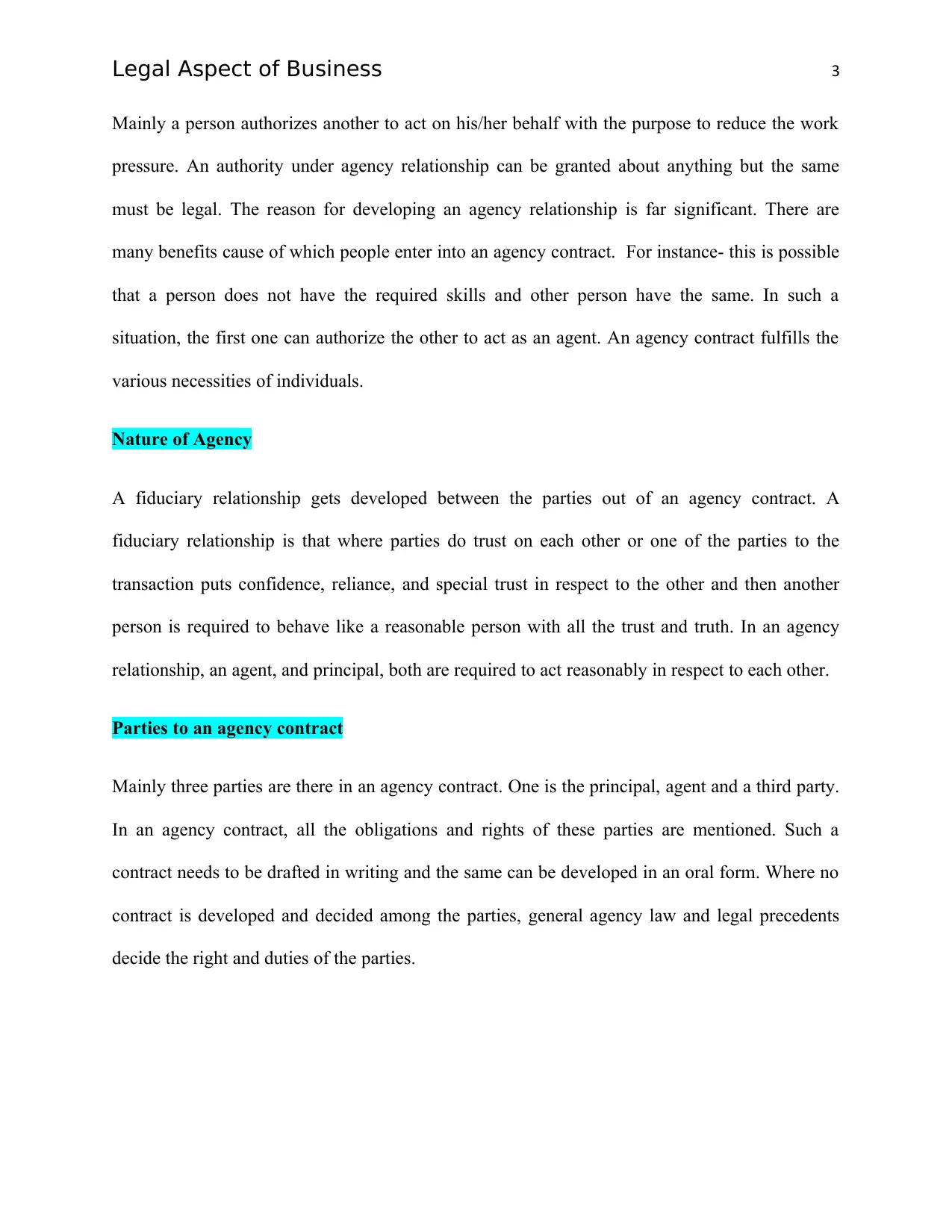
Legal Aspect of Business 3
Mainly a person authorizes another to act on his/her behalf with the purpose to reduce the work
pressure. An authority under agency relationship can be granted about anything but the same
must be legal. The reason for developing an agency relationship is far significant. There are
many benefits cause of which people enter into an agency contract. For instance- this is possible
that a person does not have the required skills and other person have the same. In such a
situation, the first one can authorize the other to act as an agent. An agency contract fulfills the
various necessities of individuals.
Nature of Agency
A fiduciary relationship gets developed between the parties out of an agency contract. A
fiduciary relationship is that where parties do trust on each other or one of the parties to the
transaction puts confidence, reliance, and special trust in respect to the other and then another
person is required to behave like a reasonable person with all the trust and truth. In an agency
relationship, an agent, and principal, both are required to act reasonably in respect to each other.
Parties to an agency contract
Mainly three parties are there in an agency contract. One is the principal, agent and a third party.
In an agency contract, all the obligations and rights of these parties are mentioned. Such a
contract needs to be drafted in writing and the same can be developed in an oral form. Where no
contract is developed and decided among the parties, general agency law and legal precedents
decide the right and duties of the parties.
Mainly a person authorizes another to act on his/her behalf with the purpose to reduce the work
pressure. An authority under agency relationship can be granted about anything but the same
must be legal. The reason for developing an agency relationship is far significant. There are
many benefits cause of which people enter into an agency contract. For instance- this is possible
that a person does not have the required skills and other person have the same. In such a
situation, the first one can authorize the other to act as an agent. An agency contract fulfills the
various necessities of individuals.
Nature of Agency
A fiduciary relationship gets developed between the parties out of an agency contract. A
fiduciary relationship is that where parties do trust on each other or one of the parties to the
transaction puts confidence, reliance, and special trust in respect to the other and then another
person is required to behave like a reasonable person with all the trust and truth. In an agency
relationship, an agent, and principal, both are required to act reasonably in respect to each other.
Parties to an agency contract
Mainly three parties are there in an agency contract. One is the principal, agent and a third party.
In an agency contract, all the obligations and rights of these parties are mentioned. Such a
contract needs to be drafted in writing and the same can be developed in an oral form. Where no
contract is developed and decided among the parties, general agency law and legal precedents
decide the right and duties of the parties.
Paraphrase This Document
Need a fresh take? Get an instant paraphrase of this document with our AI Paraphraser
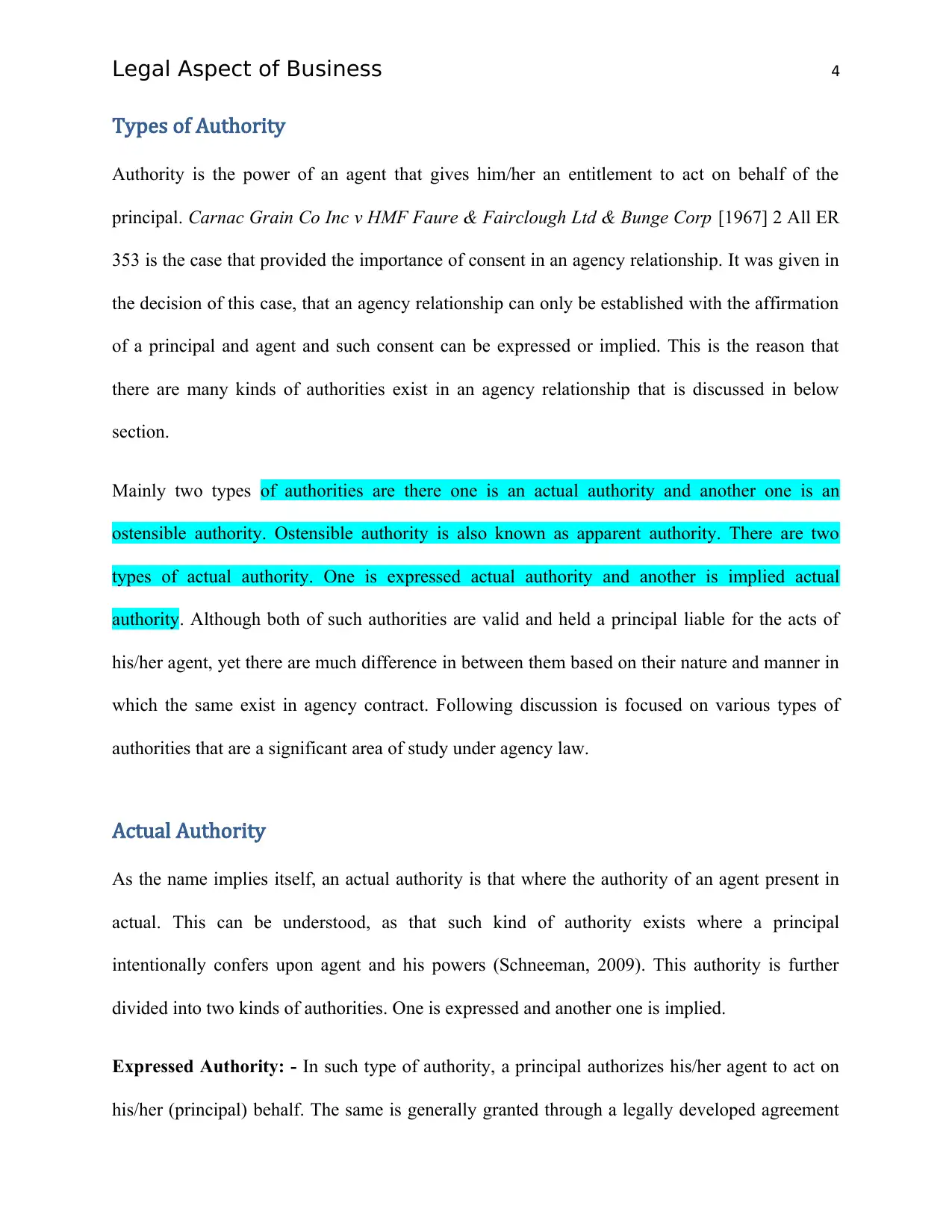
Legal Aspect of Business 4
Types of Authority
Authority is the power of an agent that gives him/her an entitlement to act on behalf of the
principal. Carnac Grain Co Inc v HMF Faure & Fairclough Ltd & Bunge Corp [1967] 2 All ER
353 is the case that provided the importance of consent in an agency relationship. It was given in
the decision of this case, that an agency relationship can only be established with the affirmation
of a principal and agent and such consent can be expressed or implied. This is the reason that
there are many kinds of authorities exist in an agency relationship that is discussed in below
section.
Mainly two types of authorities are there one is an actual authority and another one is an
ostensible authority. Ostensible authority is also known as apparent authority. There are two
types of actual authority. One is expressed actual authority and another is implied actual
authority. Although both of such authorities are valid and held a principal liable for the acts of
his/her agent, yet there are much difference in between them based on their nature and manner in
which the same exist in agency contract. Following discussion is focused on various types of
authorities that are a significant area of study under agency law.
Actual Authority
As the name implies itself, an actual authority is that where the authority of an agent present in
actual. This can be understood, as that such kind of authority exists where a principal
intentionally confers upon agent and his powers (Schneeman, 2009). This authority is further
divided into two kinds of authorities. One is expressed and another one is implied.
Expressed Authority: - In such type of authority, a principal authorizes his/her agent to act on
his/her (principal) behalf. The same is generally granted through a legally developed agreement
Types of Authority
Authority is the power of an agent that gives him/her an entitlement to act on behalf of the
principal. Carnac Grain Co Inc v HMF Faure & Fairclough Ltd & Bunge Corp [1967] 2 All ER
353 is the case that provided the importance of consent in an agency relationship. It was given in
the decision of this case, that an agency relationship can only be established with the affirmation
of a principal and agent and such consent can be expressed or implied. This is the reason that
there are many kinds of authorities exist in an agency relationship that is discussed in below
section.
Mainly two types of authorities are there one is an actual authority and another one is an
ostensible authority. Ostensible authority is also known as apparent authority. There are two
types of actual authority. One is expressed actual authority and another is implied actual
authority. Although both of such authorities are valid and held a principal liable for the acts of
his/her agent, yet there are much difference in between them based on their nature and manner in
which the same exist in agency contract. Following discussion is focused on various types of
authorities that are a significant area of study under agency law.
Actual Authority
As the name implies itself, an actual authority is that where the authority of an agent present in
actual. This can be understood, as that such kind of authority exists where a principal
intentionally confers upon agent and his powers (Schneeman, 2009). This authority is further
divided into two kinds of authorities. One is expressed and another one is implied.
Expressed Authority: - In such type of authority, a principal authorizes his/her agent to act on
his/her (principal) behalf. The same is generally granted through a legally developed agreement
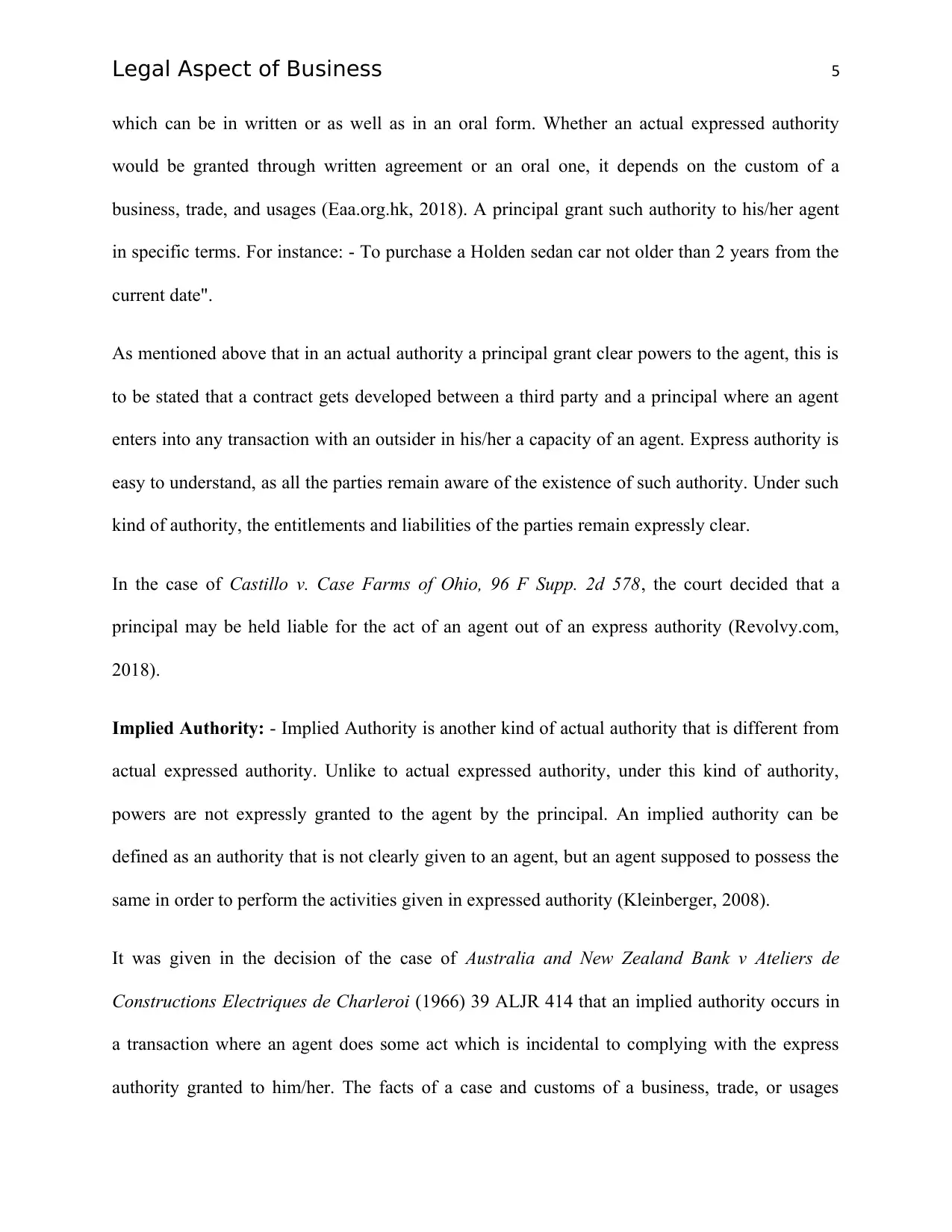
Legal Aspect of Business 5
which can be in written or as well as in an oral form. Whether an actual expressed authority
would be granted through written agreement or an oral one, it depends on the custom of a
business, trade, and usages (Eaa.org.hk, 2018). A principal grant such authority to his/her agent
in specific terms. For instance: - To purchase a Holden sedan car not older than 2 years from the
current date".
As mentioned above that in an actual authority a principal grant clear powers to the agent, this is
to be stated that a contract gets developed between a third party and a principal where an agent
enters into any transaction with an outsider in his/her a capacity of an agent. Express authority is
easy to understand, as all the parties remain aware of the existence of such authority. Under such
kind of authority, the entitlements and liabilities of the parties remain expressly clear.
In the case of Castillo v. Case Farms of Ohio, 96 F Supp. 2d 578, the court decided that a
principal may be held liable for the act of an agent out of an express authority (Revolvy.com,
2018).
Implied Authority: - Implied Authority is another kind of actual authority that is different from
actual expressed authority. Unlike to actual expressed authority, under this kind of authority,
powers are not expressly granted to the agent by the principal. An implied authority can be
defined as an authority that is not clearly given to an agent, but an agent supposed to possess the
same in order to perform the activities given in expressed authority (Kleinberger, 2008).
It was given in the decision of the case of Australia and New Zealand Bank v Ateliers de
Constructions Electriques de Charleroi (1966) 39 ALJR 414 that an implied authority occurs in
a transaction where an agent does some act which is incidental to complying with the express
authority granted to him/her. The facts of a case and customs of a business, trade, or usages
which can be in written or as well as in an oral form. Whether an actual expressed authority
would be granted through written agreement or an oral one, it depends on the custom of a
business, trade, and usages (Eaa.org.hk, 2018). A principal grant such authority to his/her agent
in specific terms. For instance: - To purchase a Holden sedan car not older than 2 years from the
current date".
As mentioned above that in an actual authority a principal grant clear powers to the agent, this is
to be stated that a contract gets developed between a third party and a principal where an agent
enters into any transaction with an outsider in his/her a capacity of an agent. Express authority is
easy to understand, as all the parties remain aware of the existence of such authority. Under such
kind of authority, the entitlements and liabilities of the parties remain expressly clear.
In the case of Castillo v. Case Farms of Ohio, 96 F Supp. 2d 578, the court decided that a
principal may be held liable for the act of an agent out of an express authority (Revolvy.com,
2018).
Implied Authority: - Implied Authority is another kind of actual authority that is different from
actual expressed authority. Unlike to actual expressed authority, under this kind of authority,
powers are not expressly granted to the agent by the principal. An implied authority can be
defined as an authority that is not clearly given to an agent, but an agent supposed to possess the
same in order to perform the activities given in expressed authority (Kleinberger, 2008).
It was given in the decision of the case of Australia and New Zealand Bank v Ateliers de
Constructions Electriques de Charleroi (1966) 39 ALJR 414 that an implied authority occurs in
a transaction where an agent does some act which is incidental to complying with the express
authority granted to him/her. The facts of a case and customs of a business, trade, or usages
⊘ This is a preview!⊘
Do you want full access?
Subscribe today to unlock all pages.

Trusted by 1+ million students worldwide
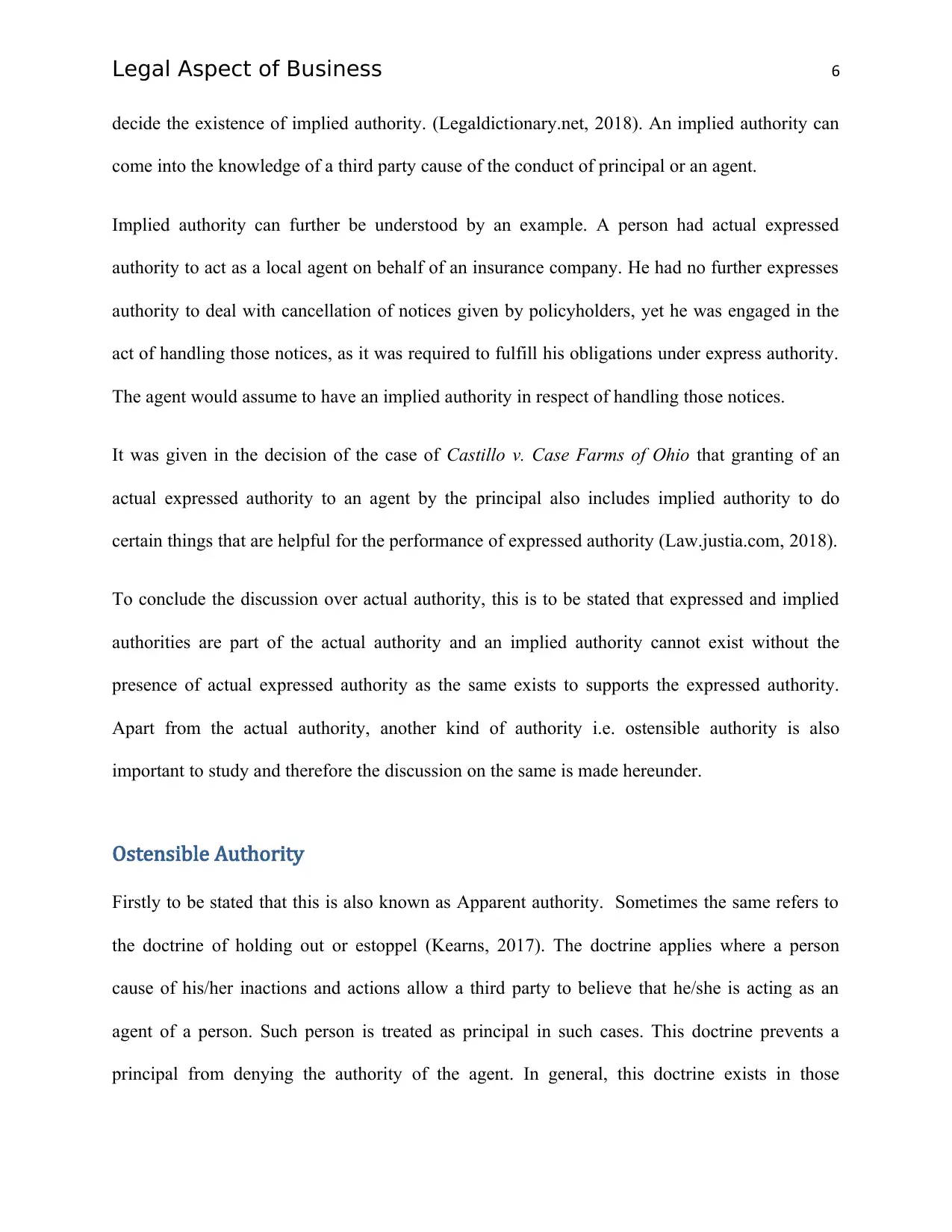
Legal Aspect of Business 6
decide the existence of implied authority. (Legaldictionary.net, 2018). An implied authority can
come into the knowledge of a third party cause of the conduct of principal or an agent.
Implied authority can further be understood by an example. A person had actual expressed
authority to act as a local agent on behalf of an insurance company. He had no further expresses
authority to deal with cancellation of notices given by policyholders, yet he was engaged in the
act of handling those notices, as it was required to fulfill his obligations under express authority.
The agent would assume to have an implied authority in respect of handling those notices.
It was given in the decision of the case of Castillo v. Case Farms of Ohio that granting of an
actual expressed authority to an agent by the principal also includes implied authority to do
certain things that are helpful for the performance of expressed authority (Law.justia.com, 2018).
To conclude the discussion over actual authority, this is to be stated that expressed and implied
authorities are part of the actual authority and an implied authority cannot exist without the
presence of actual expressed authority as the same exists to supports the expressed authority.
Apart from the actual authority, another kind of authority i.e. ostensible authority is also
important to study and therefore the discussion on the same is made hereunder.
Ostensible Authority
Firstly to be stated that this is also known as Apparent authority. Sometimes the same refers to
the doctrine of holding out or estoppel (Kearns, 2017). The doctrine applies where a person
cause of his/her inactions and actions allow a third party to believe that he/she is acting as an
agent of a person. Such person is treated as principal in such cases. This doctrine prevents a
principal from denying the authority of the agent. In general, this doctrine exists in those
decide the existence of implied authority. (Legaldictionary.net, 2018). An implied authority can
come into the knowledge of a third party cause of the conduct of principal or an agent.
Implied authority can further be understood by an example. A person had actual expressed
authority to act as a local agent on behalf of an insurance company. He had no further expresses
authority to deal with cancellation of notices given by policyholders, yet he was engaged in the
act of handling those notices, as it was required to fulfill his obligations under express authority.
The agent would assume to have an implied authority in respect of handling those notices.
It was given in the decision of the case of Castillo v. Case Farms of Ohio that granting of an
actual expressed authority to an agent by the principal also includes implied authority to do
certain things that are helpful for the performance of expressed authority (Law.justia.com, 2018).
To conclude the discussion over actual authority, this is to be stated that expressed and implied
authorities are part of the actual authority and an implied authority cannot exist without the
presence of actual expressed authority as the same exists to supports the expressed authority.
Apart from the actual authority, another kind of authority i.e. ostensible authority is also
important to study and therefore the discussion on the same is made hereunder.
Ostensible Authority
Firstly to be stated that this is also known as Apparent authority. Sometimes the same refers to
the doctrine of holding out or estoppel (Kearns, 2017). The doctrine applies where a person
cause of his/her inactions and actions allow a third party to believe that he/she is acting as an
agent of a person. Such person is treated as principal in such cases. This doctrine prevents a
principal from denying the authority of the agent. In general, this doctrine exists in those
Paraphrase This Document
Need a fresh take? Get an instant paraphrase of this document with our AI Paraphraser
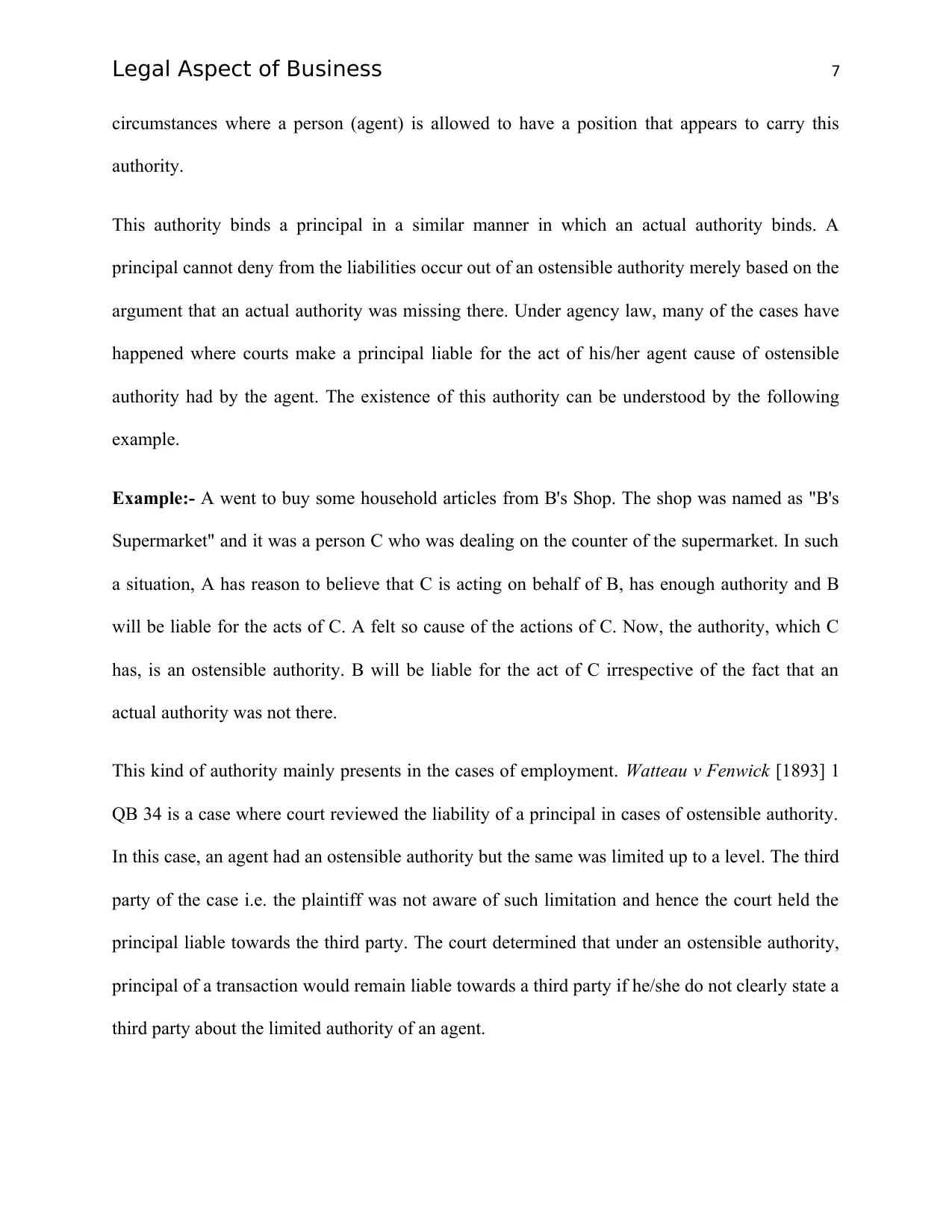
Legal Aspect of Business 7
circumstances where a person (agent) is allowed to have a position that appears to carry this
authority.
This authority binds a principal in a similar manner in which an actual authority binds. A
principal cannot deny from the liabilities occur out of an ostensible authority merely based on the
argument that an actual authority was missing there. Under agency law, many of the cases have
happened where courts make a principal liable for the act of his/her agent cause of ostensible
authority had by the agent. The existence of this authority can be understood by the following
example.
Example:- A went to buy some household articles from B's Shop. The shop was named as "B's
Supermarket" and it was a person C who was dealing on the counter of the supermarket. In such
a situation, A has reason to believe that C is acting on behalf of B, has enough authority and B
will be liable for the acts of C. A felt so cause of the actions of C. Now, the authority, which C
has, is an ostensible authority. B will be liable for the act of C irrespective of the fact that an
actual authority was not there.
This kind of authority mainly presents in the cases of employment. Watteau v Fenwick [1893] 1
QB 34 is a case where court reviewed the liability of a principal in cases of ostensible authority.
In this case, an agent had an ostensible authority but the same was limited up to a level. The third
party of the case i.e. the plaintiff was not aware of such limitation and hence the court held the
principal liable towards the third party. The court determined that under an ostensible authority,
principal of a transaction would remain liable towards a third party if he/she do not clearly state a
third party about the limited authority of an agent.
circumstances where a person (agent) is allowed to have a position that appears to carry this
authority.
This authority binds a principal in a similar manner in which an actual authority binds. A
principal cannot deny from the liabilities occur out of an ostensible authority merely based on the
argument that an actual authority was missing there. Under agency law, many of the cases have
happened where courts make a principal liable for the act of his/her agent cause of ostensible
authority had by the agent. The existence of this authority can be understood by the following
example.
Example:- A went to buy some household articles from B's Shop. The shop was named as "B's
Supermarket" and it was a person C who was dealing on the counter of the supermarket. In such
a situation, A has reason to believe that C is acting on behalf of B, has enough authority and B
will be liable for the acts of C. A felt so cause of the actions of C. Now, the authority, which C
has, is an ostensible authority. B will be liable for the act of C irrespective of the fact that an
actual authority was not there.
This kind of authority mainly presents in the cases of employment. Watteau v Fenwick [1893] 1
QB 34 is a case where court reviewed the liability of a principal in cases of ostensible authority.
In this case, an agent had an ostensible authority but the same was limited up to a level. The third
party of the case i.e. the plaintiff was not aware of such limitation and hence the court held the
principal liable towards the third party. The court determined that under an ostensible authority,
principal of a transaction would remain liable towards a third party if he/she do not clearly state a
third party about the limited authority of an agent.
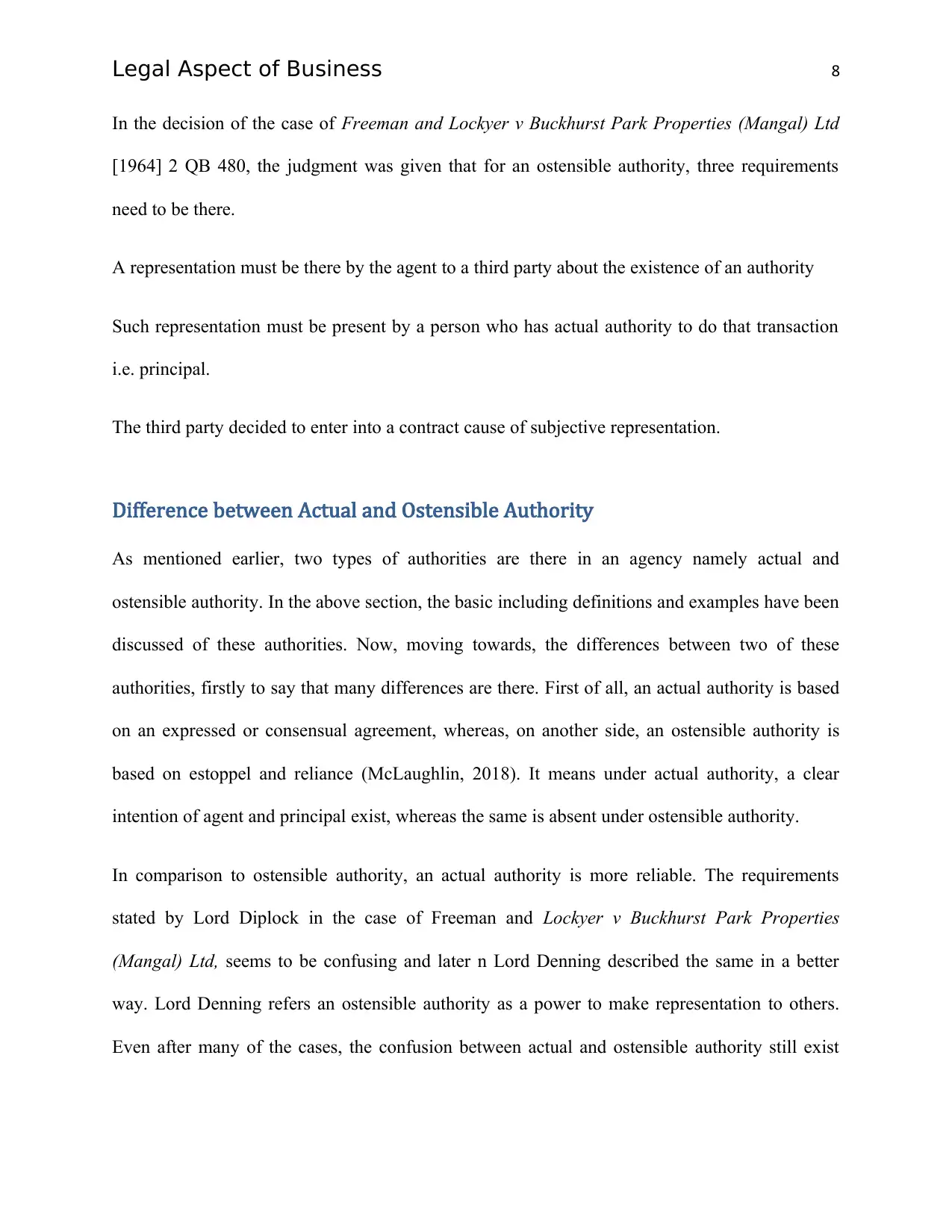
Legal Aspect of Business 8
In the decision of the case of Freeman and Lockyer v Buckhurst Park Properties (Mangal) Ltd
[1964] 2 QB 480, the judgment was given that for an ostensible authority, three requirements
need to be there.
A representation must be there by the agent to a third party about the existence of an authority
Such representation must be present by a person who has actual authority to do that transaction
i.e. principal.
The third party decided to enter into a contract cause of subjective representation.
Difference between Actual and Ostensible Authority
As mentioned earlier, two types of authorities are there in an agency namely actual and
ostensible authority. In the above section, the basic including definitions and examples have been
discussed of these authorities. Now, moving towards, the differences between two of these
authorities, firstly to say that many differences are there. First of all, an actual authority is based
on an expressed or consensual agreement, whereas, on another side, an ostensible authority is
based on estoppel and reliance (McLaughlin, 2018). It means under actual authority, a clear
intention of agent and principal exist, whereas the same is absent under ostensible authority.
In comparison to ostensible authority, an actual authority is more reliable. The requirements
stated by Lord Diplock in the case of Freeman and Lockyer v Buckhurst Park Properties
(Mangal) Ltd, seems to be confusing and later n Lord Denning described the same in a better
way. Lord Denning refers an ostensible authority as a power to make representation to others.
Even after many of the cases, the confusion between actual and ostensible authority still exist
In the decision of the case of Freeman and Lockyer v Buckhurst Park Properties (Mangal) Ltd
[1964] 2 QB 480, the judgment was given that for an ostensible authority, three requirements
need to be there.
A representation must be there by the agent to a third party about the existence of an authority
Such representation must be present by a person who has actual authority to do that transaction
i.e. principal.
The third party decided to enter into a contract cause of subjective representation.
Difference between Actual and Ostensible Authority
As mentioned earlier, two types of authorities are there in an agency namely actual and
ostensible authority. In the above section, the basic including definitions and examples have been
discussed of these authorities. Now, moving towards, the differences between two of these
authorities, firstly to say that many differences are there. First of all, an actual authority is based
on an expressed or consensual agreement, whereas, on another side, an ostensible authority is
based on estoppel and reliance (McLaughlin, 2018). It means under actual authority, a clear
intention of agent and principal exist, whereas the same is absent under ostensible authority.
In comparison to ostensible authority, an actual authority is more reliable. The requirements
stated by Lord Diplock in the case of Freeman and Lockyer v Buckhurst Park Properties
(Mangal) Ltd, seems to be confusing and later n Lord Denning described the same in a better
way. Lord Denning refers an ostensible authority as a power to make representation to others.
Even after many of the cases, the confusion between actual and ostensible authority still exist
⊘ This is a preview!⊘
Do you want full access?
Subscribe today to unlock all pages.

Trusted by 1+ million students worldwide
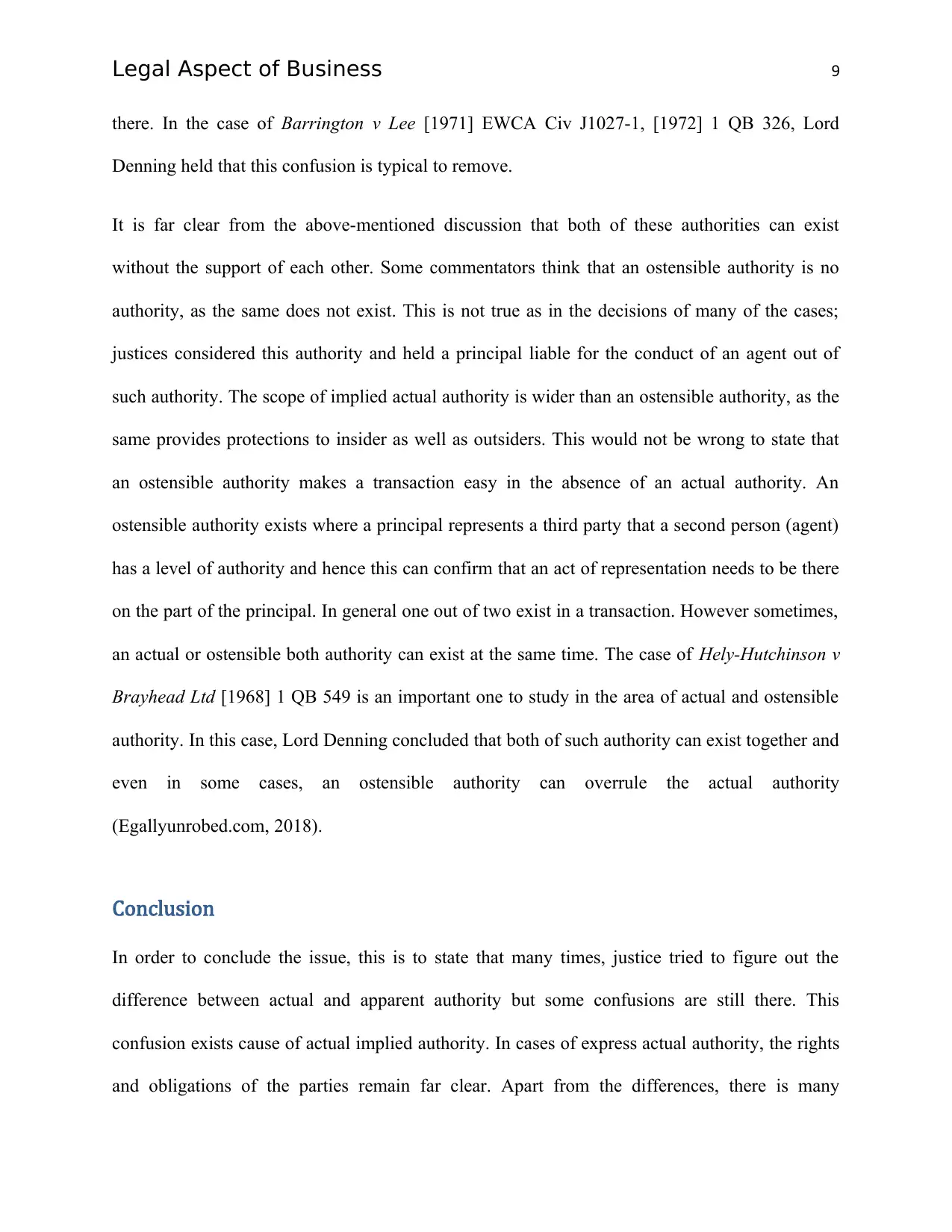
Legal Aspect of Business 9
there. In the case of Barrington v Lee [1971] EWCA Civ J1027-1, [1972] 1 QB 326, Lord
Denning held that this confusion is typical to remove.
It is far clear from the above-mentioned discussion that both of these authorities can exist
without the support of each other. Some commentators think that an ostensible authority is no
authority, as the same does not exist. This is not true as in the decisions of many of the cases;
justices considered this authority and held a principal liable for the conduct of an agent out of
such authority. The scope of implied actual authority is wider than an ostensible authority, as the
same provides protections to insider as well as outsiders. This would not be wrong to state that
an ostensible authority makes a transaction easy in the absence of an actual authority. An
ostensible authority exists where a principal represents a third party that a second person (agent)
has a level of authority and hence this can confirm that an act of representation needs to be there
on the part of the principal. In general one out of two exist in a transaction. However sometimes,
an actual or ostensible both authority can exist at the same time. The case of Hely-Hutchinson v
Brayhead Ltd [1968] 1 QB 549 is an important one to study in the area of actual and ostensible
authority. In this case, Lord Denning concluded that both of such authority can exist together and
even in some cases, an ostensible authority can overrule the actual authority
(Egallyunrobed.com, 2018).
Conclusion
In order to conclude the issue, this is to state that many times, justice tried to figure out the
difference between actual and apparent authority but some confusions are still there. This
confusion exists cause of actual implied authority. In cases of express actual authority, the rights
and obligations of the parties remain far clear. Apart from the differences, there is many
there. In the case of Barrington v Lee [1971] EWCA Civ J1027-1, [1972] 1 QB 326, Lord
Denning held that this confusion is typical to remove.
It is far clear from the above-mentioned discussion that both of these authorities can exist
without the support of each other. Some commentators think that an ostensible authority is no
authority, as the same does not exist. This is not true as in the decisions of many of the cases;
justices considered this authority and held a principal liable for the conduct of an agent out of
such authority. The scope of implied actual authority is wider than an ostensible authority, as the
same provides protections to insider as well as outsiders. This would not be wrong to state that
an ostensible authority makes a transaction easy in the absence of an actual authority. An
ostensible authority exists where a principal represents a third party that a second person (agent)
has a level of authority and hence this can confirm that an act of representation needs to be there
on the part of the principal. In general one out of two exist in a transaction. However sometimes,
an actual or ostensible both authority can exist at the same time. The case of Hely-Hutchinson v
Brayhead Ltd [1968] 1 QB 549 is an important one to study in the area of actual and ostensible
authority. In this case, Lord Denning concluded that both of such authority can exist together and
even in some cases, an ostensible authority can overrule the actual authority
(Egallyunrobed.com, 2018).
Conclusion
In order to conclude the issue, this is to state that many times, justice tried to figure out the
difference between actual and apparent authority but some confusions are still there. This
confusion exists cause of actual implied authority. In cases of express actual authority, the rights
and obligations of the parties remain far clear. Apart from the differences, there is many
Paraphrase This Document
Need a fresh take? Get an instant paraphrase of this document with our AI Paraphraser
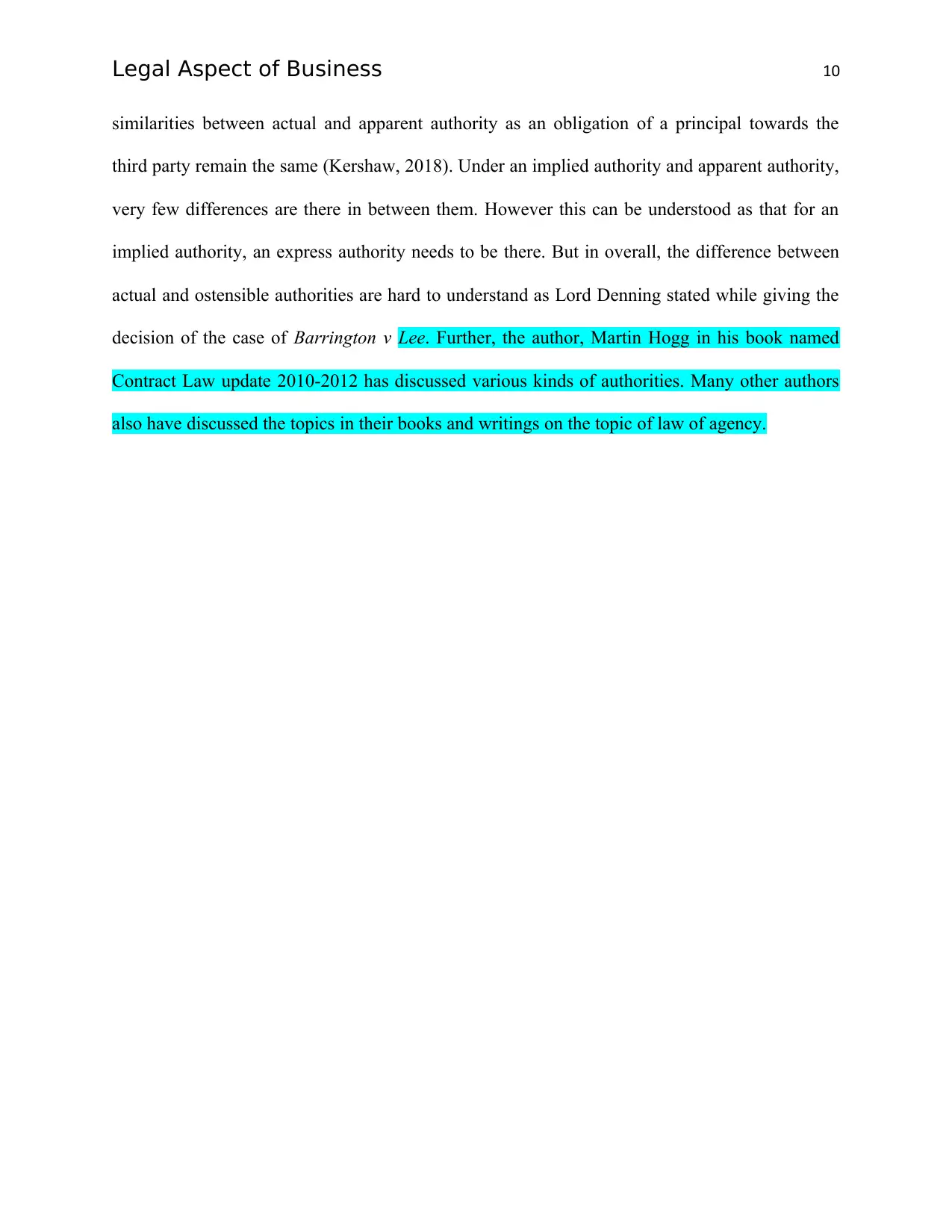
Legal Aspect of Business 10
similarities between actual and apparent authority as an obligation of a principal towards the
third party remain the same (Kershaw, 2018). Under an implied authority and apparent authority,
very few differences are there in between them. However this can be understood as that for an
implied authority, an express authority needs to be there. But in overall, the difference between
actual and ostensible authorities are hard to understand as Lord Denning stated while giving the
decision of the case of Barrington v Lee. Further, the author, Martin Hogg in his book named
Contract Law update 2010-2012 has discussed various kinds of authorities. Many other authors
also have discussed the topics in their books and writings on the topic of law of agency.
similarities between actual and apparent authority as an obligation of a principal towards the
third party remain the same (Kershaw, 2018). Under an implied authority and apparent authority,
very few differences are there in between them. However this can be understood as that for an
implied authority, an express authority needs to be there. But in overall, the difference between
actual and ostensible authorities are hard to understand as Lord Denning stated while giving the
decision of the case of Barrington v Lee. Further, the author, Martin Hogg in his book named
Contract Law update 2010-2012 has discussed various kinds of authorities. Many other authors
also have discussed the topics in their books and writings on the topic of law of agency.
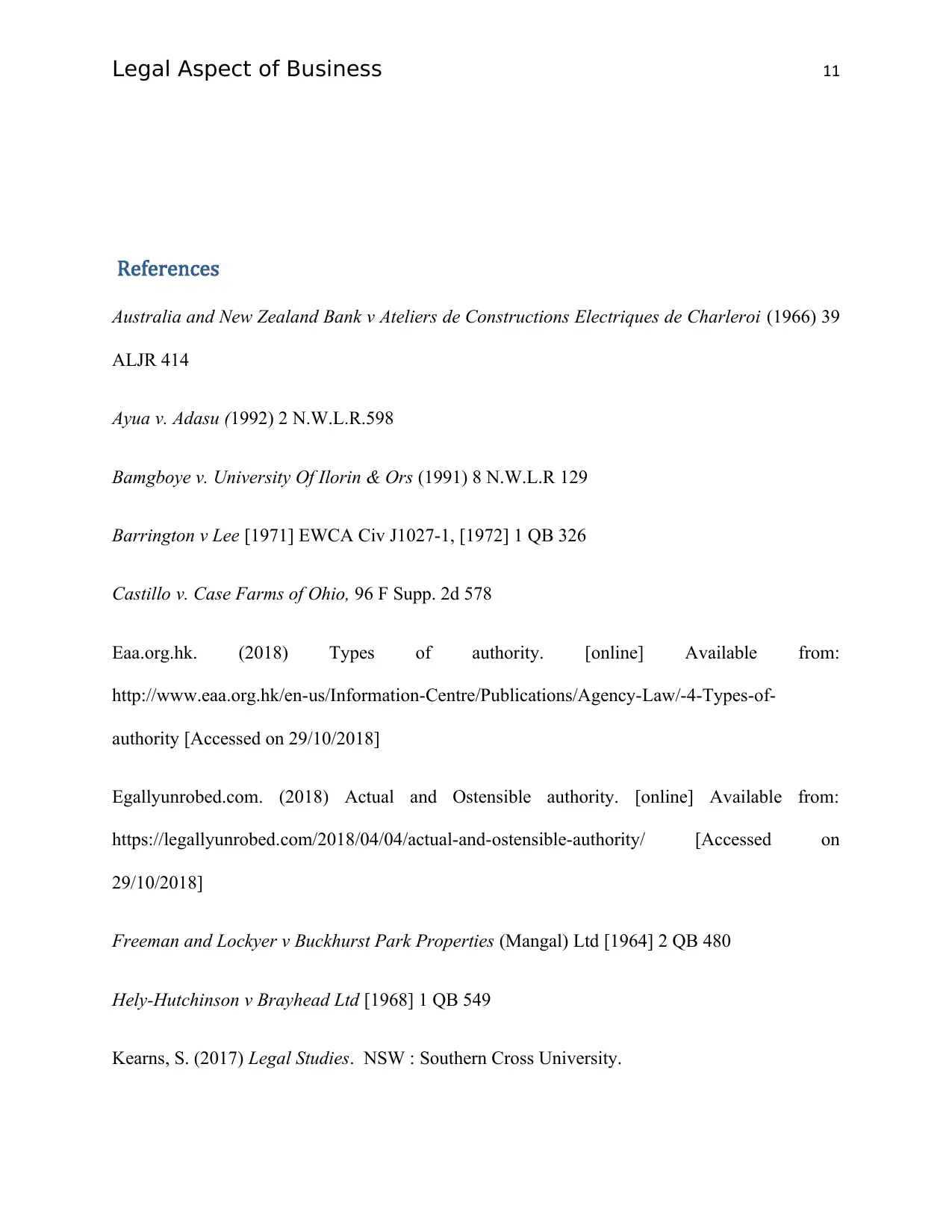
Legal Aspect of Business 11
References
Australia and New Zealand Bank v Ateliers de Constructions Electriques de Charleroi (1966) 39
ALJR 414
Ayua v. Adasu (1992) 2 N.W.L.R.598
Bamgboye v. University Of Ilorin & Ors (1991) 8 N.W.L.R 129
Barrington v Lee [1971] EWCA Civ J1027-1, [1972] 1 QB 326
Castillo v. Case Farms of Ohio, 96 F Supp. 2d 578
Eaa.org.hk. (2018) Types of authority. [online] Available from:
http://www.eaa.org.hk/en-us/Information-Centre/Publications/Agency-Law/-4-Types-of-
authority [Accessed on 29/10/2018]
Egallyunrobed.com. (2018) Actual and Ostensible authority. [online] Available from:
https://legallyunrobed.com/2018/04/04/actual-and-ostensible-authority/ [Accessed on
29/10/2018]
Freeman and Lockyer v Buckhurst Park Properties (Mangal) Ltd [1964] 2 QB 480
Hely-Hutchinson v Brayhead Ltd [1968] 1 QB 549
Kearns, S. (2017) Legal Studies. NSW : Southern Cross University.
References
Australia and New Zealand Bank v Ateliers de Constructions Electriques de Charleroi (1966) 39
ALJR 414
Ayua v. Adasu (1992) 2 N.W.L.R.598
Bamgboye v. University Of Ilorin & Ors (1991) 8 N.W.L.R 129
Barrington v Lee [1971] EWCA Civ J1027-1, [1972] 1 QB 326
Castillo v. Case Farms of Ohio, 96 F Supp. 2d 578
Eaa.org.hk. (2018) Types of authority. [online] Available from:
http://www.eaa.org.hk/en-us/Information-Centre/Publications/Agency-Law/-4-Types-of-
authority [Accessed on 29/10/2018]
Egallyunrobed.com. (2018) Actual and Ostensible authority. [online] Available from:
https://legallyunrobed.com/2018/04/04/actual-and-ostensible-authority/ [Accessed on
29/10/2018]
Freeman and Lockyer v Buckhurst Park Properties (Mangal) Ltd [1964] 2 QB 480
Hely-Hutchinson v Brayhead Ltd [1968] 1 QB 549
Kearns, S. (2017) Legal Studies. NSW : Southern Cross University.
⊘ This is a preview!⊘
Do you want full access?
Subscribe today to unlock all pages.

Trusted by 1+ million students worldwide
1 out of 13
Related Documents
Your All-in-One AI-Powered Toolkit for Academic Success.
+13062052269
info@desklib.com
Available 24*7 on WhatsApp / Email
![[object Object]](/_next/static/media/star-bottom.7253800d.svg)
Unlock your academic potential
Copyright © 2020–2025 A2Z Services. All Rights Reserved. Developed and managed by ZUCOL.




